GT-T floating tracked carrier
The idea of creating a new floating tracked carrier in the USSR was addressed at the end of the 1950s. In 1958-1960, the machine was developed by the designers of the Kharkov Tractor Plant. The model received the designation "product 21", its production was planned to expand on the recently built Rubtsovsk machine-building plant (today a branch of the Scientific and Production Corporation "Uralvagonzavod"). The first two conveyor hulls were built at the new plant at the end of 1961 of the year. In March 1962, the main conveyor for their assembly was successfully put into operation, and the first two products were assembled and put into operation. During the entire 1962 year, an installment batch consisting of five cars was additionally released. The following year, the production volume of GT-T transporters is already 10 machines per month, and by the end of 1966, it reached a stable level at all-terrain vehicles 110-120 monthly.
In 1968, a branch of RMZ for the production of floating all-terrain vehicles GT-T in Semipalatinsk was organized, and since 1977, the production of these machines, which were assembled more than 10 thousand pieces, was finally transferred to the branch. In the period from 1983 to the beginning of 1990-ies in Semipalatinsk they were annually assembled and sold around 600-700 tracked tractor-tractors GT-T. In 1990-s, work was carried out to modernize the machine, in particular, the B-6A diesel engine was replaced with more advanced and powerful YMZ-238 Yaroslavl engines. The engine compartment was moved to the middle part of the tractor, which made it possible to achieve a more uniform weight distribution of the machine. We also developed rollers with the most wear-resistant polyurethane coating.
GT-T construction
Tracked heavy conveyor-tractor is a high-speed vehicle of high throughput, able to float, with bearing body and front drive wheels. This conveyor tractor with an independent torsion bar suspension is designed to transport people and various goods off-road in conditions of wooded and swampy terrain and snowy virgin lands in the Far North and Polar regions with simultaneous towing of special wheeled ski trailers or other systems with a total mass of no more than 4's tons. The carrying capacity of the conveyor itself 2 tons or 23 person, the crew - 2 person. The movement of the conveyor on the water was provided by a tracked propulsion unit. To increase the speed of movement of the conveyor afloat when overcoming various water barriers, quick-detachable hydrodynamic shields can be installed on the front flaps of the GT-T hull.
The GT-T conveyor was equipped with water-draining means, which consisted of a mechanical centrifugal as well as a manual piston pump. By the standard set of spare parts of this all-terrain vehicle means of increasing the patency were attached. For example, additional lugs could be used to improve the grip of the tracks of the conveyor with the ground, and special chains and a “legendary” log could be used for self-pulling when stuck, without which it is difficult to imagine models of Soviet armored vehicles today.
The operation of this vehicle in off-road conditions, highly rugged terrain with the presence of small vegetation and deep water obstacles did not cause any complaints. In winter, the conveyor-tractor could be used at extremely low ambient temperatures. Due to its qualities, the GT-T was widely used in the Soviet Army until the collapse of the USSR. In addition to the army, the car was in demand and the national economy. The tracked tractor GT-T fully managed to share the glory of the pioneers of the development of the North, who with the help of this machine successfully passed through virgin forests and unsteady peatlands (Mari).
The bearing body of the caterpillar heavy conveyor tractor was all-metal, welded frame construction. The base of the case was sealed, the body - open type. The body of the all-terrain vehicle was divided into three sections: the engine-transmission, the cabin and the body. In the front part there was a logging equipment, which was separated from the cabin by special partitions and fences of the engine located in the center of the cabin. To the left of the engine was the place of the GT-T driver and chassis controls. In the middle part of the body of the all-terrain vehicle was a four-seater cabin, and in the aft there was a body. The body and the cabin were not separated. On top of the body could be closed with a special awning from canvas fabric.
The heart of the conveyor tractor was a 6-cylinder four-stroke diesel engine B-6A liquid cooling, it developed the maximum power 200 hp at 1800 rpm The engine worked in conjunction with a mechanical double-flow transmission with two planetary friction turning mechanisms. The transmission had 5 forward gears and one - rear. The maximum theoretical TG-T speed on paved roads in fifth gear was 45,5 km / h, the maximum back speed was limited to 6,54 km / h. In this case, according to the technical documentation and operating instructions, the average technical speed of the TG-T tractor when driving on a dry dirt road of average quality with a load and trailer was 22-24 km / h. The average fuel consumption was 90-110 liters per 100 kilometers, which provided the car with a power reserve of about 500 km.
The chassis of the GT-T conveyor tractor consisted of six pairs of rubber-coated bearing rollers. In front of the car were driving wheels, in the back - guide wheels. Tracked tape included 92 small link with articulated-floating fingers and zevochnom gear. All-terrain vehicle suspension was independent torsion bar. The movement of the machine afloat was ensured by the track-type propulsion unit, the maximum speed of the GT-T in calm water did not exceed 6 km / h. To increase the speed of motion afloat, quick-release hydrodynamic guards could be used.
Modern modifications and upgrades GT-T
Currently, the Rubtsovsk branch of OAO NPK Uralvagonzavod offers its customers a civilian version of a snow-swamp-going tracked carrier-tractor under the designation GT-TM. This snow and swamp-going vehicle is intended for transportation of rotational and repair crews, delivery of oversized cargo to areas with severe soil and climatic conditions. In front of the GT-TM there is a vibration-noise insulated cabin for the driver and two passengers, in the rear part there is a passenger-cargo tent body. Control of the tracked-type tracked off-road vehicle with a hydro-volume steering mechanism. The engine compartment is located in a closed compartment, to which, if necessary, maintenance is provided free access. The design of the crawler conveyor tractor allows the towing of special equipment and trailers. In this case, the conveyor is able to overcome water obstacles on the move.
The all-terrain vehicle is equipped with a more powerful 8-cylinder V-shaped diesel engine of liquid cooling JAMZ-238BV with a displacement of 14,86 liter. This engine of the Yaroslavl Motor Plant develops the power of the HP 310. (228 kW). The mass of GT-TM in the curb state reaches 11,6 tons. The load capacity of the body has grown to 2500 kg, the mass of the towed trailer - to 5000 kg. According to the official website of the Rubtsovsk Machine-Building Plant, the maximum speed of the all-terrain vehicle, due to the installation of a more powerful diesel engine, increased to 60 km / h, the range of fuel is 600 km. Temperature operation of the GT-TM crawler conveyor tractor is possible in the range from -45 to + 45 degrees Celsius.
In the Russian market today you can find other upgrades of the famous Soviet conveyor-tractor. For example, the company “Snowbutter”, a member of the group of companies GIRTEK, over more than 15 years of its activity, has overhauled and upgraded more than 1000 various Soviet-made snow and swamper roads, including GT-T. Currently, the company offers a model of the conveyor with the 8-cylinder engine YMZ-238V horsepower 240. The maximum speed of such an all-terrain vehicle is 55 km / h. In addition, the company can manufacture and install on the all-terrain vehicle a metal insulated passenger cabin (kung) designed for an 12 person.
In addition, the company offers a deeply modernized cargo-to-passenger version of the GT-T all-terrain vehicle with a chassis that was extended by one roller (became 7) and with the YMZ-238BL-1 engine with 310 horsepower. The load capacity of this version has increased to 4000 kg (1500 kg more than MTLB). The total number of passengers in the new enlarged cabin, which was insulated with “penoplex” and sheathed with plywood, is 8 people. Also installation of the cabin heating system was made.
The advantages of the GT-T tracked conveyor-towing vehicles, which allow them to remain in demand in the market in the XXI century, include their outstanding characteristics. This snow and swamp-going vehicle is considered to be one of the most passable, among all models presented on the domestic market. Its weight is less than that of MTLB, and the caterpillar is wider - 560 mm. In aggregate, this provides the ground pressure at the level - less than 0,25 kgf / cm2.
Tactical and technical characteristics of the GT-T:
Overall dimensions: length - 6340 mm, width - 3140 mm (on track chains), height - 2160 mm.
Mass - 8,2 tons (refilled, with spare parts, without cargo in the back and crew).
Body carrying capacity - tons of 2.
The weight of the towed trailer - 4 tons.
The number of seats is 4 (in the cab), 21 (in the back).
The power plant is a four-stroke diesel engine В-6А liquid cooling capacity HP 200. (at 1800 rpm).
The maximum speed is 45,5 km / h.
Maximum speed afloat - 6 km / h (in calm water).
Fuel tank capacity - 550 l.
Power reserve - 500 km.
Information sources:
http://www.uvzrmz.ru/product/100
http://www.russianarms.ru/forum/index.php?topic=471.0
http://snegobolotohod.ru/projects/gusenichnyj_tyagach_gt-t__gruzo-passazhirskij_s_dvigatelem_yamz-238
Open source materials
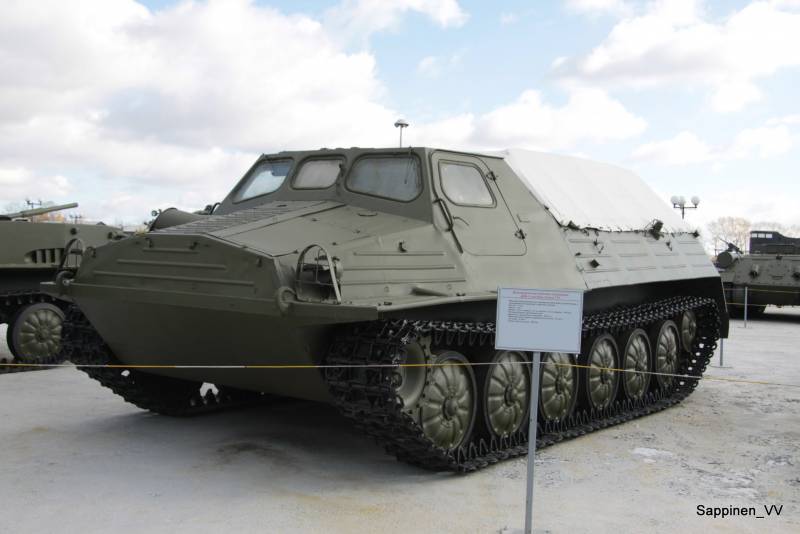
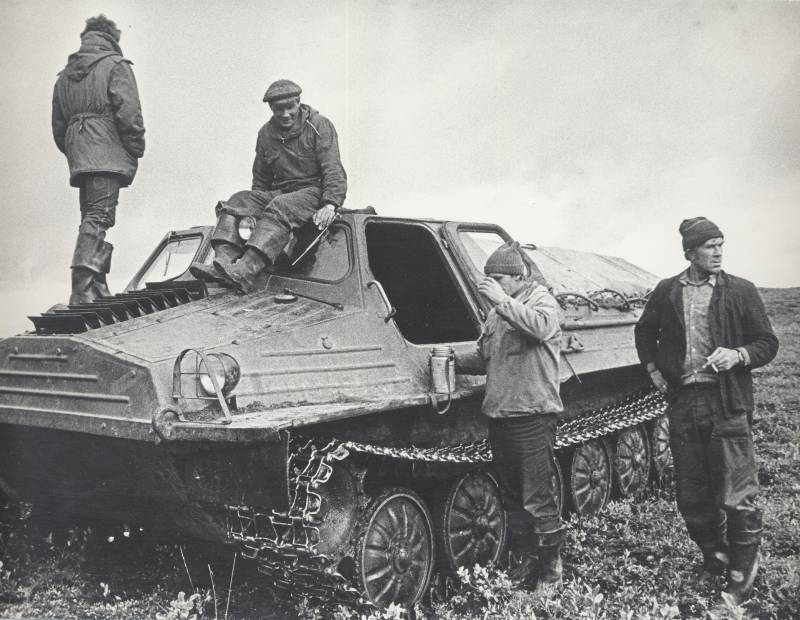
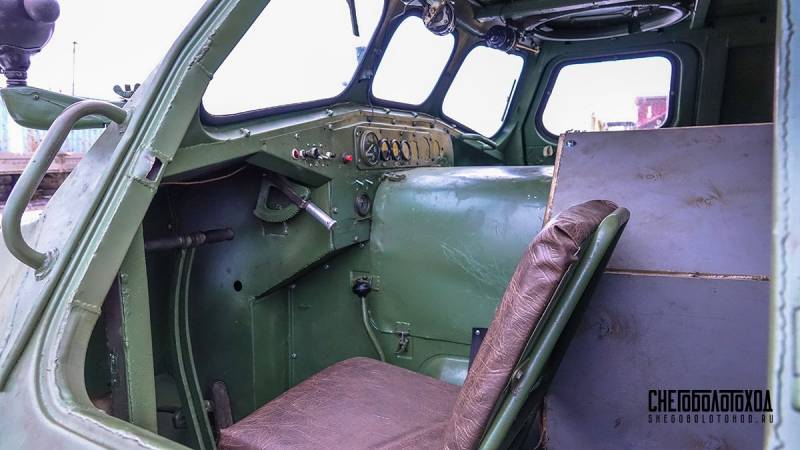
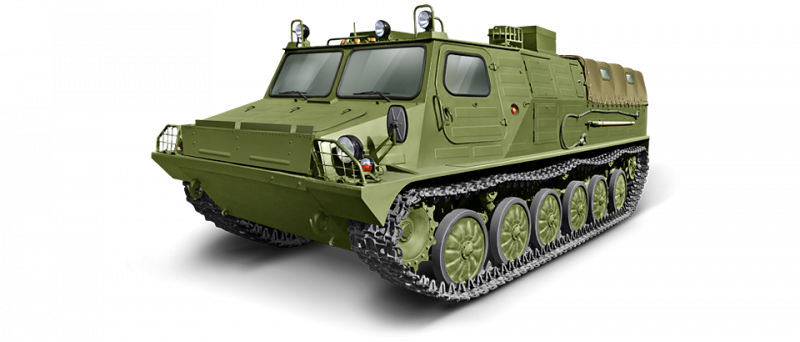
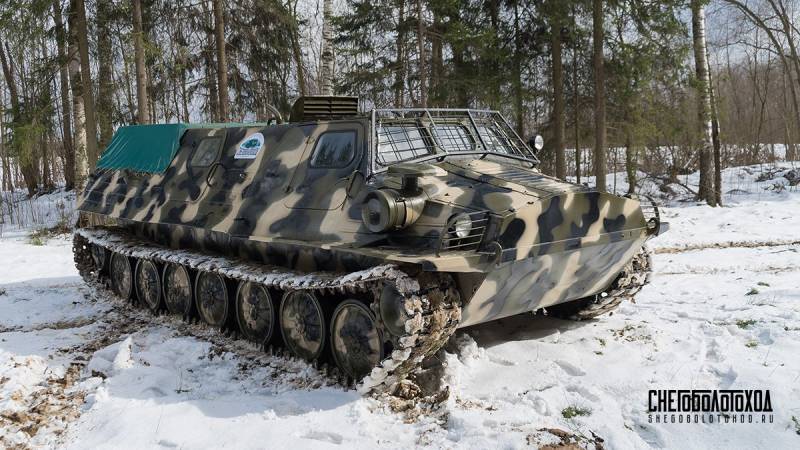
Information